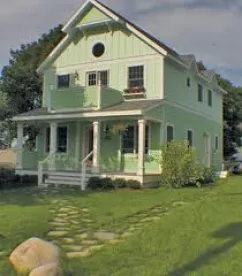Introduction
State law in North Carolina authorized modern local zoning regulations in the 1920s. And perhaps, there is no more basic zoning term than “single family detached dwelling.” In a world of ever-increasing complexity of uses and transitory land planning theories, we hope that a term as omnipresent and basic as single family detached dwelling possesses a clear and certain universal meaning. Unfortunately, after almost one-hundred (100) years of law our hope has yet to be realized.
In the case of Long v. Currituck County,___N.C. App.___, 2016WL3394346 (June 21, 2016), we discover the meaning of “single family detached dwelling”, at least in Currituck County under the County’s Unified Development Ordinance (County UDO) as it existed when the parties disagreed. By reading Long, two things are apparent. First, the meaning of single family detached dwelling, in certain fact patterns, is not simple and apparent; and second, understanding the meaning and application of even the most rudimentary zoning term requires significant effort and analysis.
Long v. Currituck County
Facts
Ms. Letendre owned an ocean-front lot on the Outer Banks in Currituck County. The lot was encumbered with two sets of land use regulations. The development on the lot had to comply with the state Coastal Area Management Act (CAMA) and the County UDO. Under CAMA, the larger the structure that was located on the lot, the wider the required setback from the ocean became. The County UDO allowed “a single-family detached dwelling” on the lot.
Ms. Letendre proposed constructing three buildings on the lot, all of which were individually 5000 square feet in size. All three buildings contained sleeping and sanitary facilities. The main building, facing the ocean, contained the common cooking facilities for all three buildings. The two other buildings were “wings” of the main building and were connected to the main building by conditioned hallways (collectively the “Project”).
Focusing upon the functionality of the three buildings as a single dwelling unit, the Planning Director determined the Project was a single-family dwelling unit. The Longs (next door neighbors) appealed the Planning Director’s interpretation to the County Board of Adjustment. The Board of Adjustment affirmed the Planning Director’s interpretation. The Longs appealed the Board of Adjustment’s decision to the Superior Court. The Superior Court affirmed the Board of Adjustment’s decision.
The Longs appealed the Superior Court’s decision to the North Carolina Court of Appeals. The Court of Appeals unanimously reversed the Superior Court, concluding that “[t]he project does not fit with the plain language of the definition of Single Family Dwelling and thus is not appropriate in the SF District.” Long, p. 6. The Court of Appeals remanded the case for further proceedings consistent with its opinion.
The Court of Appeals’ Analysis
The County UDO defined the term ‘Dwelling, Single-Family Detached’ and the Court of Appeals focused upon this definition. The Court of Appeals found that the definition had “five elements” and the Project was required to satisfy each element of the definition. According to the Court of Appeals, three (3) of the elements addressed the physical structure of the proposed dwelling and two (2) of the elements addressed the use and function of the proposed dwelling.
The County’s interpretation of the term emphasized the use and function of the proposed dwelling as a single family detached dwelling, but overlooked the physical structure requirements of the definition. The Project included three buildings and the definitional elements of (1) a residential building (2) not physically attached to any other principal structure meant that the Project was not a single family detached dwelling under the County UDO. Accordingly, the Project was not permitted in the SF Zoning District of the County UDO.
The Court of Appeals bolstered its conclusion by surveying various definitions of other types of dwellings in the County UDO. The Court of Appeals noted that the other definitions contained primarily functional elements; whereas, the definition of single family detached dwelling was the only definition that included “a residential building.” Therefore, this language could not be superfluous and must be a necessary element of the definition.
Likewise, the Court of Appeals noted that accessory structures may be attached to a principal structure, but the wings did not satisfy the definition of accessory structures because the definition for accessory structure required these structures to be subordinate in use and square footage.
Finally, the Court of Appeals considered the County’s argument that the Longs’ interpretation could create absurd consequences. The Court of Appeals concluded that the Planning Director’s interpretation could lead to “a more absurd result” because an unlimited number of large structures could be built on a single lot so long as only one structure contained a common kitchen. Long, p. 5. As the Court of Appeals noted, the SF District was established to “accommodate very low density residential development in a manner that preserves sensitive natural resources, protects wildlife habitat, recognizing the inherent limitations on development due to lack of infrastructure and seeking to minimize damage from flooding and catastrophic weather events.” Id.
Comments
1. The parties’ positions in Long were well argued and the Court of Appeals meticulously examined the County’s UDO and the parties’ position. The literal language of local land use law controls most interpretation questions. The practical point is that ordinances require continuous study, review and refinement.
2. Long illustrates the complexity of development today. It seems probable that the property owner developed this unusual configuration of buildings to minimize the impact of the CAMA regulations and to maximize utilization and value of her ocean-front lot in an area with significant summer rental of “cottages.” The viability of a creative design turns on close reading of defined terms.
3. Long demonstrates that assumptions and methodology may subtlety alter meanings. The Court of Appeals divided parts of a single integrated extended definition into separate elements for analytical purposes. However, the definition itself does not set out these parts as separate elements. If the definition had not been divided into separate elements, did the property owner have a better argument? For example, was an ambiguity in the extended definition cured by the framework used by the Court? After all, all ambiguities are construed in favor of the free use of land.




 />i
/>i
